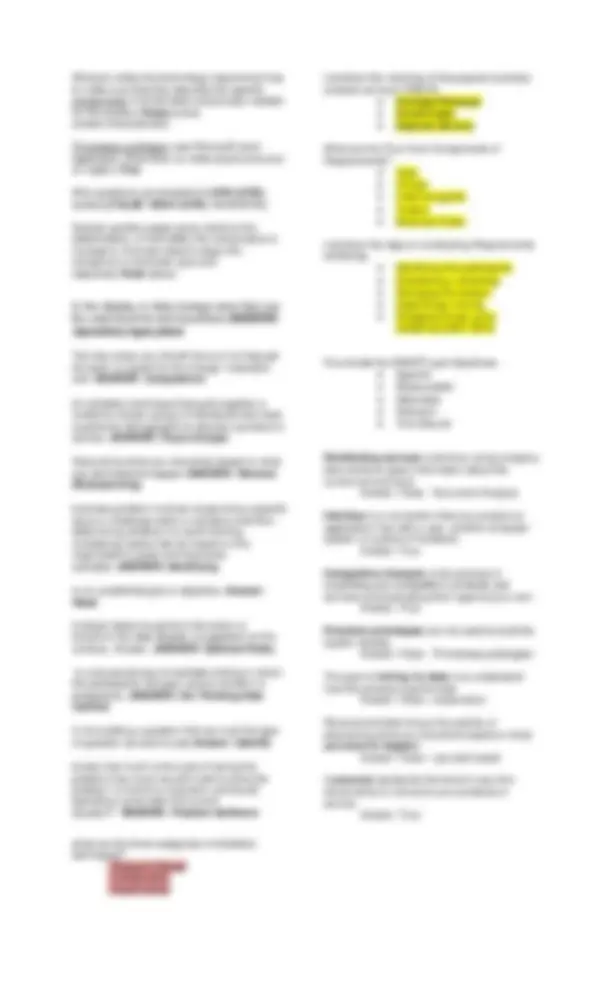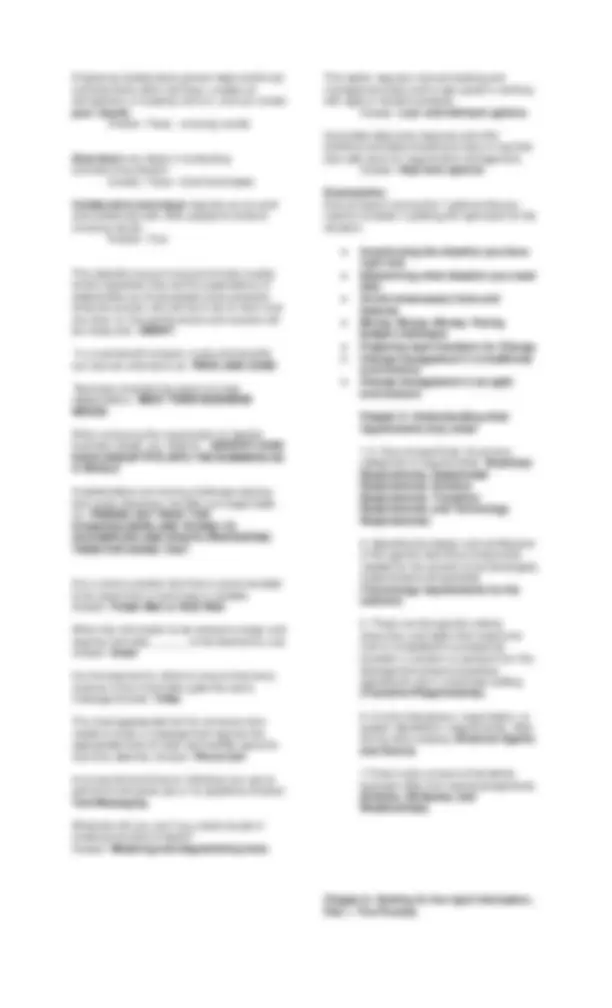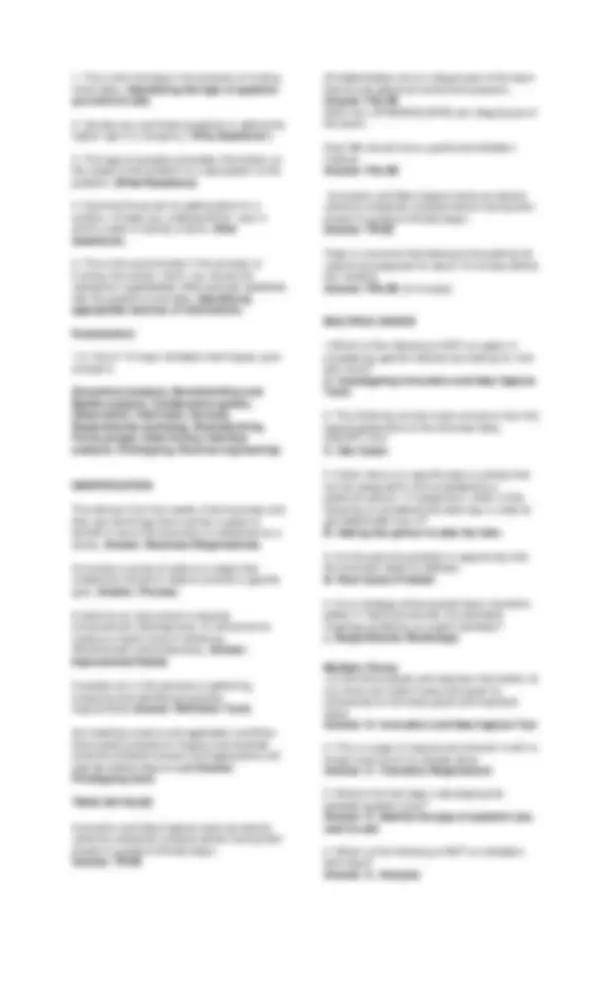





Study with the several resources on Docsity

Earn points by helping other students or get them with a premium plan


Prepare for your exams
Study with the several resources on Docsity

Earn points to download
Earn points by helping other students or get them with a premium plan
Community
Ask the community for help and clear up your study doubts
Discover the best universities in your country according to Docsity users
Free resources
Download our free guides on studying techniques, anxiety management strategies, and thesis advice from Docsity tutors
Reviewer about business analytics
Typology: Summaries
1 / 6

This page cannot be seen from the preview
Don't miss anything!




This level of analysis works where you can have an interaction with the department heads and line managers.- OPERATIONAL LEVEL
When a project manager wants to have a list of stakeholders through a chart that shows their different responsibilities for the project, what kind of tool can a project manager use?- RACI MATRIX
It is a framework that helps teams and organizations deliver value via an incremental and iterative approach.- SCRUM
It is a fixed-length timebox, typically between two and four weeks, in which the Scrum team's aim is to complete the goal that they commit to at the beginning of the sprint.- SPRINT
They are testing the products before launching it to the market and or to deliver a quality product without defects.- QUALITY ASSURANCE PERSONNEL
A project manager is accountable for creating a business plan.- TRUE
If a company needs a product manual for its customer to show how it works, what kind of project support personnel do they need?- TECHNICAL WRITER
When a company's goal is to sell more mobile phones, the other organization sells accessories, and the other one is selling software apps, in what level of analysis work does this effort?- ORGANIZATIONAL LEVEL
is a research discipline of identifying business needs and determining solutions to business problems. Solutions often include a systems development component, but may also consist of process improvement, organizational change or strategic planning and policy development. - BUSINESS ANALYSIS
One of the common barriers to effective communications within a company is cultural and language differences.- TRUE
At the enterprise level, it focuses on optimizing the activities and processes of a company.- FALSE
Project Manager is a generic term for a person or a group of people who have interset in an initiative and will be affected by it or have influence over it.- FALSE
They are experts in the particular business or solution area you are working in for your project.- SUBJECT MATTER EXPERTS
Business analysis makes businesses do business better. – TRUE
Outstanding communication is considered a skill of a successful Business Analyst. - TRUE
Flexibility only adapts to changes to project requirements. – FALSE
Rapport is gaining a person's trust by showing concern, further needs and communicating badly. - FALSE
A message is only as good as it's received. - TRUE
It is another agile framework with the lack of a timebox.- LEAN KANBAN
It can adapt to volatile environments, where requirements may be fluid.- CHANGE-DRIVEN APPROACH
It is best when organizations need to test and learn as they go and then pivot quickly- AGILE APPROACH
It is responsible for maintaining the Guide to the Business Analysis Body of Knowledge.- IIBA
Who do you usually work with at the Enterprise Level?- THE 'C' LEVEL OFFICERS
This level shows the collection of distinct business areas or general regions that make up a company.- ORGANIZATIONAL LEVEL
This is another step-down in the hierarchy, meaning, you're getting into a more specific area such as departments within the regions or divisions- OPERATIONAL LEVEL
This level offers the biggest picture of a company. This is where most of the strategic work and highest-priority and most-visible projects usually reside.- ENTERPRISE LEVEL
Who do you usually work with at the Operational Level?- HEADS MANAGER OR DIRECTOR
This is the lowest level of analysis and is where most of the business analysis work at companies happens.- PROJECT LEVEL
When evaluating communication tools to use, you should consider the following except;- DELIVERY OF SPEECH
In picking the right tools for the situation what should you NOT consider?- DISREGARDING THE NEEDS OF YOUR TEAM AND PROJECT
It is the use of statistical analysis techniques to discover patterns and relationships in data. – MINING DATA
It is the process of identifying specific requirements or problems and then examining them in depth to gain a comprehensive understanding of their underlying causes and motivations. – UNCOVERING AND ANALYZING NEEDS
It is the decision about whether to do something to achieve the objective- REQUIREMENTS
It is the biggest place of the business data, and they represent major information elements.- ENTITIES
Is a list of topics or concerns people bring up in the meetings that you don't want to address at the moment.- PARKING LOT
What type of question helps us identify the meaning behind the project or request. It requires the stakeholders to think and be conscious of their operations.Type of info to be shared?- WHY TYPE QUESTION
Focus on your markets ______ than your business' wants.- NEEDS
It analyses existing documents to determine the questions you needed to ask to the stakeholders during a elicitation session.- DOCUMENTATION ANALYSIS
Definition Tools are best defined by using graphical or visual definitions
(FALSE- by using only text)
Is Kanban board a type of low-tech tool? True
The elicitation in an Agile team is continuous and consistent True
Reverse brainstorming is working backward from the solution to understanding the data, processes, and business rules False
Uncovering the root cause means identifying the underlying reason behind a problem or issue. True
Vision statement articulates and defines the holistic need for the solution. True
Employing collaborative games helps build trust and teamwork within the team, creates an atmosphere of creativity and fun, and can render poor results Answer: False - amazing results
Shut down any ideas in conducting brainstorming session Answer: False – Don’t shut down
Collaborative technique requires you to work and collaborate with other people to achieve amazing results Answer: True
This objective ensure everyone knows exactly what's expected; they set the expectations of stakeholders so those people know precisely what the solution will and won't do for them and are clear on how performance and success will be measured.- SMART
In a cost-benefit analysis, costs and benefits can also be referred to as- PROS AND CONS
Business analysts' key goal is to help stakeholders:- MEET THEIR BUSINESS NEEDS
When analyzing the organization to identify business needs, you need to: - IDENTIFY HOW EACH GROUP FITS INTO THE BUSINESS AS A WHOLE
If stakeholders are having challenges playing their parts effectively, the BAs are responsible for- FINDING OUT WHAT THE STAKEHOLDERS ARE TRYING TO ACCOMPLISH AND WHATS PREVENTING THEM FOR DOING THAT
It is a communication tool that is recommended to be used when a hard copy is needed. Answer: Postal Mail or Snail Mail
When the information to be shared is longer and requires formality, ______ is the best tool to use. Answer: Email
It is the best tool to utilize to ensure that every receiver of the information gets the same message.Answer: Video
The most appropriate tool for someone who needs to share a message that requires the appropriate tone of voice and another person’s real-time attention.Answer: Phone Call
A convenient tool that an individual can use to ask short and quick yes or no questions.Answer: Text Messaging
What tool will you use if you need visuals in creating business analysis? Answer: Modeling and diagramming tools
This option requires manual tracking and management tricks and is also great in working with agile or iterative projects. Answer: Low- and mid-tech options
It provides data entry features and offer workflow and status tracking to stay on top that also add value for requirement management. Answer: High tech options
Enumeration Give at least 2 among the 7 options that you need to consider in picking the right tools for the situation.
Inventorying the situation you have right now Determining what situation you need later Avoid unnecessary tools and features Money, Money, Money: Facing budget challenges Preparing team members for Change Change management in a traditional environment Change management in an agile environment
Chapter 5: Understanding what requirements truly entail
1-3. Give at least three (3) primary categories of requirements. ( Business Requirements, Stakeholder Requirements, Solution Requirements, Transition Requirements, and Technology Requirements)
7.Three major concerns that define business data from logical perspectives. (Entities, Attributes, and Relationships)
Chapter 6. Hunting for the right information, Part 1. The Process
Enumeration:
1-5. Out of 13 major elicitation techniques, give at least 5.
(Document analysis, Benchmarking and Market analysis, Collaborative games, Observation, Interviews, Surveys, Requirements workshop, Brainstorming, Focus groups, Data mining, Interface analysis, Prototyping, Reverse engineering)
This derives from the needs of the business and they are the things that must be in place to benefit or serve the business or enterprise as a whole. Answer: Business Requirements
It involves a series of actions or steps that collectively transform data to achieve a specific goal. Answer: Process
It refers to an area where it requires enhancement, development, or refinement to achieve a higher level of efficiency, effectiveness and productivity. Answer: Improvement Needs
It assists you in the process of gathering, analyzing and identifying business requirements. Answer: Definition Tools
Its modeling screens and application workflow that enable analysts to imagine and illustrate what the software screens and applications will look like before they’re built. Answer: Prototyping tools
TRUE OR FALSE
Innovation and Idea Capture tools are best to utilize by enterprise analysis before having their project or product officially begin. Answer: TRUE
All stakeholders are an integral part of the team that should attend all refinement sessions. Answer: FALSE (NOT ALL STAKEHOLDERS are integral part of the team)
Each BA should have a preferred elicitation method. Answer: FALSE
Innovation and Idea Capture tools are best to utilize by enterprise analysis before having their project or product officially begin. Answer: TRUE
Topic or concerns that belong to the parking lot need to be prepared for about 10 minutes before the meeting. Answer: FALSE (5 minutes)
1.Which of the following is NOT an option in considering specific features by looking for mid- tech tools? C. Investigating Innovation and Idea Capture Tools
Multiple Choice 1.A tool that collects and organize information at any level and make it easy and quick for companies to find really good and important ideas. Answer: D. Innovation and Idea Capture Tool